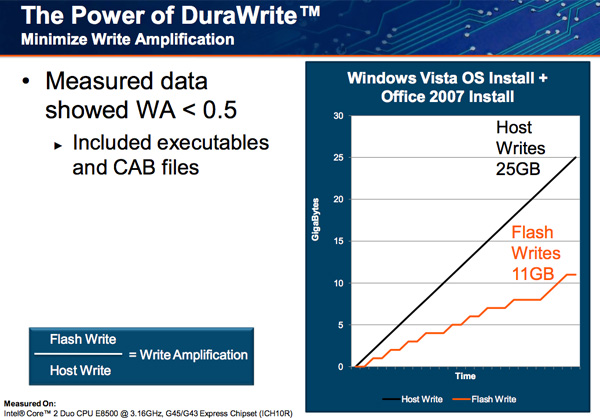SandForce Announces Next-Gen SSDs, SF-2000 Capable of 500MB/s and 60K IOPS
by Anand Lal Shimpi on October 7, 2010 9:30 AM ESTFor months SandForce has been telling me that the market is really going to get exciting once its next-generation controller is ready. I didn’t really believe it, simply because that’s what every company tells me. But in this case, at least based on what SandForce showed me, I probably should have.
What we have today are the official specs of the second-generation SandForce SSDs, the SF-2000 series. Drives will be sampling to enterprise customers in the coming weeks, but we probably won’t see shipping hardware until Q1 2011 if everything goes according to plan. And the specs are astounding:

We'll get to the how in a moment, but let's start at the basics. The overall architecture of the SF-2000 remains unchanged from what we have today with the SF-1200/SF-1500 controllers.
SandForce’s controller gets around the inherent problems with writing to NAND by simply writing less. Using real time compression and data deduplication algorithms, the SF controllers store a representation of your data and not the actual data itself. The reduced data stored on the drive is also encrypted and stored redundantly across the NAND to guarantee against dataloss from page level or block level failures. Both of these features are made possible by the fact that there’s simply less data to manage.

Another side effect of SandForce’s write-less policy is there’s no need for an external DRAM to handle large mapping tables. It reduces the total BOM cost of the SSD and allows SandForce to charge a premium for its controllers.

These are the basics and as I mentioned above, they haven’t changed. The new SF-2000 controller is faster but the fundamental algorithms remain the same. The three areas that have been improved however are the NAND interface, the on-chip memories, and the encryption engine.










84 Comments
View All Comments
Rasterman - Sunday, October 17, 2010 - link
Anyone have any guesses on sizes and prices?ABR - Tuesday, October 19, 2010 - link
I don't give much of a hoot about 6GB/s controllers and sequential performance. I'd be happier to see a 1.5GB/s interface actually utilized. Real desktop and a lot of server use consists of overlapping highly random reads, and moderately random writes. Loading an application with tons of resource files, saving documents and state to 3 or 4 directories at once, things like that. This is the whole big win of SSDs: eliminating the seek time. So I don't care about some 500MB/s number if you happen to be copying a giant file from one freshly written drive to a new blank drive. I do care about random access to a heavily used disk, and this is still sitting back in the realm of 10's of MB/s.In fact this whole hoopla about ever-increasing pure sequential transfers reminds me of the megahertz wars -- everyone shouted 10 years ago about this several hundred MHz or that GHz, meanwhile memory (and hence most actual computing) poked along at tens of MHz. Most of the progress in CPUs since that time has been in using all kinds of fancy branch prediction and pipelining structures exactly for the purpose of dealing with memory latency.
Powersupply - Wednesday, October 27, 2010 - link
Good post!kevith - Wednesday, October 20, 2010 - link
It certainly looks as if we are approaching some amazing speeds in the months to come, lovely.But what is it with RAID, that makes it pop up every now and then in storage-reviews?
"... the sort of performance you’ll be able to get through a multi-drive array will be staggering..."
As far as I can read in every single test of RAID-0 vs single drives I´ve ever read - here at Anandtech inclusive - it appears, that there is no real difference in speed with a RAID-0 setup.
In synthetic benchmarks, there is a measurable effect, but in everyday use there is none.
A lot of folks in various forums claim they have doubled their transfer-speed, some even tripled, but everytime a serious Magazine like Your own, Tom´s, BitTech or others try to find out just how great it is, it always end up the same way: No bang for the buck at all.
Are there maybe new aspects when we´re talking SSD´s, that I am not aware of?